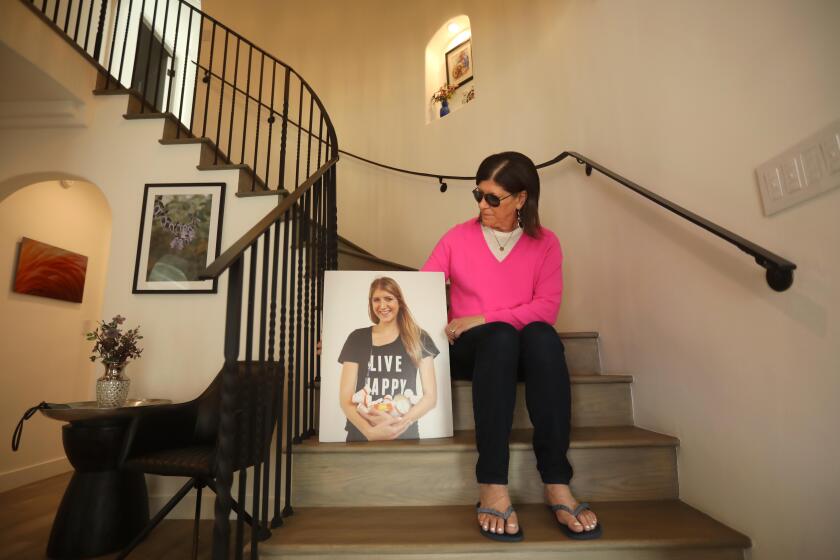650,000 Polio Survivors at Risk as Disease Returns : Health: Leading researcher of the syndrome is also a victim. His advice to patients, who are often high achievers: Use the magic cure of rest.
Decades after polio invaded his youth and almost snuffed out his existence, Dr. Lauro Halstead is struggling with a second punch from the disease. For him, the phrase “physician heal thyself” has become a way of life.
Halstead is one of 125,000 Americans suffering from post-polio syndrome, a devastating blow delivered in middle age to patients who had polio in their youth.
But Halstead is more than a patient. He’s also one of the doctors who defined the syndrome and now heads the Post Polio Program at the National Rehabilitation Hospital.
“When I talk to patients about this condition, they seem to pay more attention because I’m fighting the same thing,” he said in an interview. “They know that I know what I’m talking about.”
Post-polio syndrome is becoming a more widely recognized menace to 650,000 American polio survivors--people who contracted the polio virus in the 1940s and 1950s, before vaccines brought the dreaded summertime crippler under control.
People who thought they had recovered fully from the effects of polio are experiencing fatigue, muscle weakness, pain, and difficulty in breathing and swallowing.
Many former polio patients are being forced to return to the braces, wheelchairs and even breathing aids that they stopped using decades ago.
The cause of the syndrome is not clear, but it seems to strike those who worked the hardest to overcome the crippling effects of their childhood polio. Halstead said it may have been the hard work of rehabilitation that is indirectly causing polio’s second bounce.
“An awful lot of polio folks tend to be high achievers,” he said. “They learned an important lesson at an early age: If you work hard, your body will reward you.”
Now, said the doctor, he is trying to teach these same people, and himself, a new lesson: the magic cure of rest.
Polio strikes motor nerves in the spinal column, destroying pathways that the body uses to send signals to muscles. The disease typically killed only a portion of those nerves and Halstead said the body is equipped with a 20% to 40% surplus.
It’s believed that the nerves untouched by disease grew new pathways to compensate for those killed by polio. These new nerves connected to muscle cells and enabled many people who were crippled by the disease to regain use of limbs. The recovery took years of exhausting and often painful exercise.
Those extra nerves now are breaking down from overuse, Halstead believes. It’s almost as if an electrical circuit, required for too long to carry too much power, is finally burning out.
The symptoms often are subtle and can go undiagnosed.
“Many patients just ignore it, think it’s because of age,” he said. But more and more of them are turning up on his office doorstep.
Halstead’s long struggle with polio began at age 18, the summer after his freshman year in college. The disease struck savagely while he was touring Europe; his life was saved by a crude breathing device--an “iron” lung made of wood--at a Spanish children’s hospital.
The breathing device was designed for children, but, somehow, doctors jammed in Halstead’s 6-foot-4 frame. It worked well enough to keep him alive through the acute phase of polio. Then he was flown back to the United States to start months of rehabilitation at a hospital near his White Plains, N.Y., home.
Polio had left him with only slight motion in his right arm--and he was right-handed--and a weakness in his legs.
It also planted in him a determination to become a doctor.
“My illness gave me some insight into what it was like to be a patient,” he said. Halstead also learned how doctors worked and recalled that “I felt like I could do that and even better.”
Halstead taught himself to write with his left hand, exercised his way back to walking. After taking an English degree from Haverford College, he persuaded the University of Rochester to ignore his disability and enroll him in medical school.
Through long years of medical training, Halstead said his endurance and stamina never wavered. For exercise, he routinely ran up six flights of stairs. Twenty-four-hour days were common during internship and residency, and he was always able to do the job. Except for a paralyzed right arm, polio seemed a half-forgotten nightmare of his youth.
That changed in 1982 while Halstead was on the faculty and medical staff at the Baylor College of Medicine in Houston.
Over several weeks, he noticed an unusual weariness and loss of energy. Then, one evening, while driving home, he stopped at a red light and promptly fell asleep. Halstead said he began to be fatigued by midafternoon most days and often had to stop and sleep.
His legs also lost their power. Just walking across parking lots at the huge Houston Medical Center became a struggle. There was no more running up stairs or working 12 to 14 hours a day. And occasionally he had breathing problems.
He was not alone. Other doctors began to report treating polio survivors with similar symptoms. Medical experts were mystified, but it was clear that patients by the hundreds were in the grip of some new syndrome.
Halstead helped organize a medical conference on the phenomenon in 1984. It was sparsely attended, but a second conference in 1986 drew national attention.
Since then, doctors have conducted formal research trying to find the precise cause of the problem and the proper treatment. Final answers are elusive. But slowly medical science is learning.
Patients have learned from experience and doctors have learned from patients. Halstead, as both a patient and a doctor, treats others as he treats himself.
“There’s been a lot of self-teaching,” he said.



